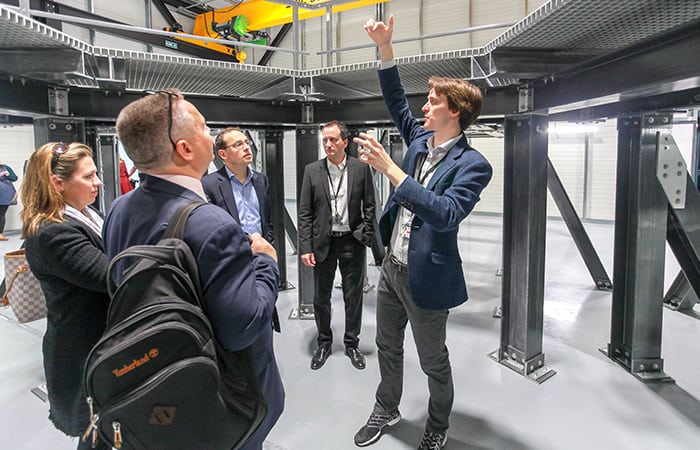
Known as Machine 3, the pulsed power device will eventually be capable of discharging 200,000 volts and in excess of 14 million amperes within two microseconds. The ‘shot’, which is equivalent to around 500 simultaneous lightning strikes, will fire a projectile at a small target containing a tiny amount of fuel, collapsing a cavity in a process known as inertial confinement and superheating plasma to achieve fusion. Though all six identical arms of Machine 3 will be needed to generate the power required for fusion, the first of these has now been successfully commissioned, with the device expected to be completed by the end of 2018.
“These were test shots but are very important nevertheless because they were the first ‘end-to-end’ tests of Machine 3,” said Nicholas Hawker, founder and CEO of First Light. “The successful outcome de-risks the rest of the project because it was based on one of the six limbs of the device. The other five limbs are exact replicas of the one we tested.
“It was a fantastic achievement for the team to be able to fire the first test shot just five months from the beginning of construction of what will be a unique facility once fully commissioned. There is nothing else like it in the world.”
When The Engineer visited First Light earlier this year, Hawker explained how its fusion concept was inspired by the pistol shrimp, a crustacean that uses its claw to create inertial confinement in tiny bubbles underwater.
“This was the starting point for my PhD, to take this phenomena, boil it down and understand it,” said Hawker, who completed his doctorate at Oxford in 2012.
Although the engineering required to design and build Machine 3 is impressive, FLF’s real expertise lies in the target design. It uses advance simulation and modelling – combined with rapid prototyping – to test many variations of target, refining the geometries constantly to maximise the energy released as the plasma collapses in on itself.
“The complexity is in the target,” Hawker told The Engineer. “We try to keep the machines simple and finesse the target with a very high-quality understanding of the physics and dynamics of what’s happening inside that target.”
“By changing this target design and having this idea of the projectile, potentially we get to a much simpler, much cheaper, technology. The whole point of First Light right now is to find the target design that actually is going to work.”
With one arm installed, the next steps will be to get the remaining five in place and achieve Machine 3’s first fusion. If successful, First Light will then set out on the path to energy gain – the Holy Grail of fusion where a reaction releases more energy than is inputted. The company has tentatively pencilled in 2024 as its target for realising gain.
“We are confident that we will reach our present goal of demonstrating fusion,” said Hawker. “Beyond that, the experimental platform that we have built with this machine will give us critical insights into the next step, which is to demonstrate gain.”





Collaboration to address viable solutions for VAWG database
<blockquote>address the lack of standardisation, coordination, and collaboration of gender disaggregated data intelligence across various regions,...